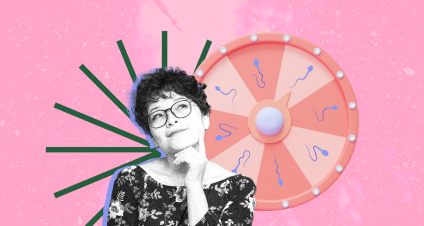Migraine is a common — and often debilitating — condition that affects millions of women, but not all migraine attacks happen at the same time or with the same frequency. For instance, a menstrual migraine attack may be triggered in a different way than a chronic migraine attack.
Understanding the distinctions between these two types is key to finding the right treatment and managing symptoms effectively. The more you notice when and how your migraine attacks present, the easier it will be to figure out what kind of treatment would work best for your unique type of migraine.
Below, we break down the differences between menstrual migraine and chronic migraine, helping you better understand your migraine and how to manage it.
What is a menstrual migraine?
Menstrual migraine is directly tied to your hormone fluctuation and is timed to either your period or when you ovulate.
According to the American Migraine Foundation, two out of three women who live with migraine live with menstrual migraine.
These migraine attacks are typically triggered by hormonal fluctuations, particularly the drop in estrogen levels that happens just before menstruation.
Menstrual migraine symptoms include expected migraine symptoms like a headache, nausea, vomiting, or sensitivity to light, but they are also uniquely timed. These migraine attacks typically happen a few days before your period and resolve once your period has tapered off. The biggest tell for a menstrual migraine is that it happens monthly at around the same time.
What is a chronic migraine?
Chronic migraine is defined by its frequency. If you experience migraine on 15 or more days per month for at least three months, you may be diagnosed with chronic migraine. Unlike menstrual migraine, chronic migraine are not uniquely tied to your menstrual cycle and can occur at any time throughout the month, however, hormonal fluctuations can still play a role in increasing their severity.
Chronic migraine is a more persistent and long-term form of migraine. It can develop from episodic migraine, which may occur less frequently, into a chronic pattern over time.
Some chronic migraine attack symptoms include 15 or more headache days per month for at least three months, moderate to severe pain, and, for some people, auras. On some days, the pain may be less intense, but the headache can still linger and interfere with daily activities.
What are the key differences between menstrual migraine and chronic migraine?
While both types of migraine involve similar symptoms, like throbbing headache pain, nausea, and sensitivity to light, there are key differences between menstrual migraine and chronic migraine.
Most notably, menstrual migraine attacks tend to resolve with the end of a period, while chronic migraine attacks can linger for several days and vary in intensity. Since a menstrual migraine is often more predictable, it is more realistic for someone to have a self-care plan at the ready for whenever their period is expected. Whereas, chronic migraine attacks may make it harder for someone to know when to expect a migraine or what to do when one occurs.
Despite the differences, both menstrual and chronic migraine are influenced by hormonal fluctuations, especially estrogen. During your menstrual cycle, a drop in estrogen can trigger a migraine, particularly for those who already have a genetic predisposition to migraine. However, while menstrual migraine occurs with more predictable timing, chronic migraine is not necessarily linked to the menstrual cycle. It may still be influenced by hormonal changes (like pregnancy, menopause, or oral contraceptives), but the pattern is less predictable.
For women with chronic migraine, the hormonal component can exacerbate their condition, but chronic migraine often has additional triggers such as stress, sleep disturbances, or environmental factors (like bright lights or strong smells).

Managing menstrual migraine and chronic migraine
Managing both types of migraine involve a combination of lifestyle adjustments, medications, and identifying triggers.
Some women find relief through hormonal treatments, such as birth control pills or hormone therapy, which can help stabilize estrogen levels and prevent migraine attacks from occurring during their periods. Over-the-counter medications like ibuprofen or acetaminophen are often a first line of defense to help alleviate pain, however, more personalized treatments (like triptans or anti-nausea medications) may be the path forward for some who live with migraine.
In addition to medication, lifestyle adjustments can also help in migraine management. For instance, for those who live with menstrual migraine, keeping track of your cycle, staying hydrated, managing stress, and getting enough sleep can help reduce the frequency of menstrual migraine.
While both menstrual migraine and chronic migraine involve similar symptoms, understanding the differences between them is essential in determining the right treatment approach. If you’re experiencing migraine tied to your menstrual cycle, it’s crucial to discuss hormonal options with your care team, including an OB/GYN or headache specialist.
Tassia O'Callaghan is an experienced content writer and strategist, having written about a vast range of topics from chemical regulations to parenting, for brands like Peanut App Ltd, Scary Mommy, Tally Workspace, and Office Christmas. She's an advocate for realistic sustainable living, supporting small businesses (author of A-Z of Marketing for Small Businesses), and equity across all walks of life. Follow her on LinkedIn or TikTok, or see more of her work on Authory or her website.








.webp)

.jpg)










